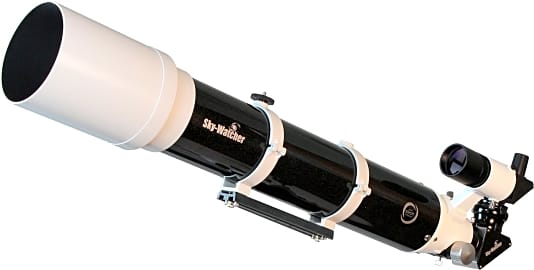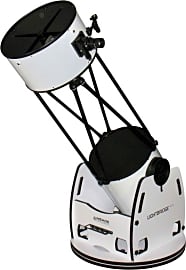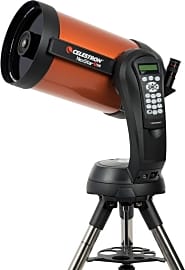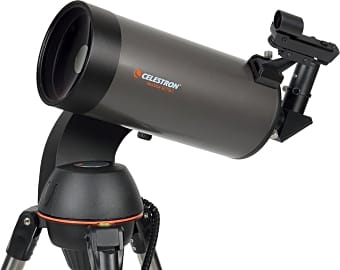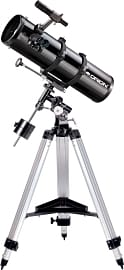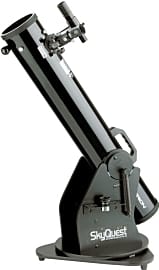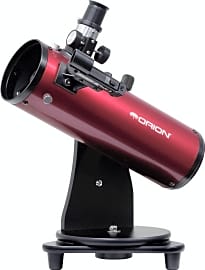The 10 Best Telescopes

This wiki has been updated 40 times since it was first published in May of 2015. Whether you are an amateur stargazer looking for a little more power or a professional astronomer, we've got you covered with our comprehensive selection of telescopes, including everything from the basic moon watcher up to computer controlled nebula viewers that can find and track distant celestial bodies. We've ranked them by price, ease of use, magnification capability, and image clarity. When users buy our independently chosen editorial recommendations, we may earn commissions to help fund the Wiki.
Editor's Notes
October 30, 2020:
While there wasn't a lot of action in this category, we did see fit to swap out an old Meade model for the Meade Instruments StarNavigator NG 130MM, which is a little more compact and portable, and that's a lot more user friendly, even if it doesn't quite have the resolving power of the other. One particularly nice feature of the NG is the red backlight on its controller, which is ideal of you're operating it frequently on a single outing and don't want the light from its screen or keypad to impact your eyes' ability to see as much of the sky as possible.
Another newcomer to this list can be found in our special honors section, where we've added the Sky-Watcher Esprit 150mm ED Triplet APO Refractor. Now, at first glance, you might not realize just how big this thing is, but it's massive. It's also worth noting that you rarely see refracting models this size, principally because the labor intensity involved in grinding objective lenses this size to the precision needed for astronomy often raises the cost too high. To be fair, this isn't an inexpensive model, but for its specs, it's a steal.
November 25, 2019:
Revisiting this list, it occurred to us that we already have a ranking dedicated to beginner's telescopes, which made us less inclined to keep any bargain items on this list, like the Celestron Powerseeker 70 we took off. It's a fine model for beginners, and we've still included some offerings that could be considered entry-level, but scopes like the Orion SkyScanner 10012 are just undeniably better, with superior optics and build quality. In the place of the Powerseeker, we included what might be a holy grail model for many amateur astronomers in the Meade Instruments LX850, whose astounding light gathering capabilities, in conjunction with its surprising portability, make it one of the most useful scopes around.
Some of the models on our previous list were replaced by their partners in brand and lineup, just sized up or down in accordance with the best value offered and the availability of certain models. The Orion SkyQuest XX16g, for example, is a bit pricier than its 14-inch brother, but the difference its wider aperture makes in your focal ratio is more than worth the increase in price for a real pro stargazer. And the 16-inch Meade Lightbridge just isn't that accessible any more, so we swapped it out for the Meade 12-Inch LightBridge instead.
Special Honors
Sky-Watcher Esprit 150mm ED Triplet APO Refractor One of the largest consumer-oriented refractors on the market, this model features fully multi-coated lenses, a 150mm primary aperture, a focal ratio of f/7, and a Helinear Track focusing system. A two-element field flattener does away with any distortion that might obscure the perfection of its views and lets you see everything to the proper scale. skywatcherusa.com
Bringing Perspective A Little Closer
The aperture determines the degree of brightness and sharpness you see through a telescope.
Humans have always been curious about the world around them. Though just the first step, this very curiosity has allowed technology to evolve along with it. By itself, curiosity does not provide all the answers, but it does encourage imagination, the desire to hone one's thoughts, the desire to grow, and to experiment with technology that will serve that curiosity. The more scientific breakthroughs that occur, the less inclined I'd be to believe human curiosity is ever satisfied.
If humans had given up on curiosity, then it's possible everyone would still believe the Earth is flat. Without an awareness of what's around you and how things appear, you wouldn't begin to suspect that perhaps the Earth was round due to the observation of moon phases over time and the spherical shape of the Earth's shadow that is cast on the moon's surface. On the same parallel, with the invention of a unique tool like the telescope, our definition of what it means to think outside the box changes dramatically.
By definition, a telescope is an optical instrument with a primary purpose of making distant objects appear close and easy to see. This is accomplished through the use of either an arrangement of lenses or, as worded in the Oxford English Dictionary, an arrangement of both curved mirrors and lenses, by which rays of light are collected, focused, and the resulting image is magnified. A majority of telescopes focus on detecting electromagnetic radiation.
One of the most important aspects of a telescope is its aperture through which light will travel. The aperture determines the degree of brightness and sharpness you see through a telescope. The diameter of a telescope's aperture is directly proportional to the level of detail you see when you look through it. As an example, a telescope with a 10-inch aperture will make distant objects appear sharper than one with only a five or six-inch aperture.
A telescope's power is another important piece of the puzzle for determining the degree of mangification it will offer. This is an integral consideration for the budding astronomer who wants to see outer space and the surrounding planets as closely and as clearly as possible.
Telescopes are classified into refracting, reflecting, and catadioptric types. They all share the same purpose of collecting light and bringing it to a point of focus so that it can be magnified with an eyepiece, but each type accomplishes this in its own way.
Refracting telescopes are the most common and usually take the form of long, thin tubes that allow light to pass in a straight line from the front objective lens right to their eyepieces. The reflecting telescope leverages a large and concave parabolic mirror to collect and focus light to a flat secondary mirror. The secondary mirror then reflects the image out of the opening at the side of the main tube. Catadioptric telescopes use both lenses and mirrors to fold optics and form an image.
A Brief History Of The Telescope
The earliest known telescopes date back to the beginning of the 17th century and are credited to Middelburg spectacle makers Hans Lippershey, Zacharias Janssen, and Dutch instrument maker Jacob Metius of Alkmaar. By the year 1609, Galileo Galilei used and improved upon the design of the Dutch telescope.
Dishes are still used today to study naturally-occurring radio light from the stars.
Galileo also became the first person to use a telescope for observing celestial objects in the sky, which has become one of the most common uses for many of the cutting-edge telescopes today. In 1668, Sir Isaac Newton invented the first practical reflector telescope, also referred to as the Newtonian reflector.
Thanks to the invention of the achromatic lens, color aberrations in objective lenses were reduced, while telescopes could be made shorter and more functional in design. These began to appear by the middle of the 18th century.
By 1931, new telescopes that produced images using wavelengths other than visible light helped to evolve a new type of observational astronomy, thanks to Karl Jansky's discovery that the Milky Way was a source of radio emissions. This further spawned the development of wavelength-specific telescopes that included the infrared, ultra-violet, X-ray, and gamma-ray telescopes.
Building on Jansky's ideas, Grote Reber built a sophisticated radio telescope in 1937 that included a thirty-one-foot dish, which made it possible to discover unexplained radio sources in the sky. Radio astronomy interest continued to grow beyond the time of World War II as dishes were leveraged in larger sizes. Dishes are still used today to study naturally-occurring radio light from the stars.
Finding The Best View Of The Night Sky
One of the first things to consider when purchasing a telescope is what you plan to use it for. For a majority of people, looking to the stars and examining the world around them are definitely reasons to go for the most highly-developed optics.
Depending on where you plan to set up your telescope, definitely make sure it comes with a sturdy stand or tripod that allows for easy mobility. Some telescopes are also designed as tabletop models, which comes in particularly handy when your bedroom desk is close to a large window.
For that person who's into technology, one must find a telescope designed with built-in Global Positioning System functionality, which can capture data from satellite positions.


